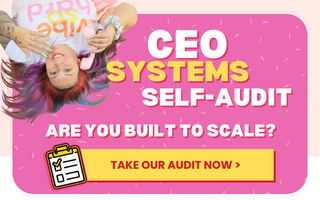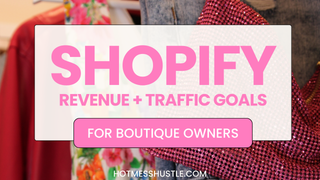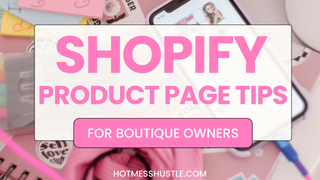At Hot Mess Consulting, we specialize in e-commerce website optimization. But what exactly does that mean? What is website optimization?
Website optimization is a process of using tools and advanced strategies to improve the performance of your website, drive more traffic and increase conversions to grow revenue.
There is a heap more to it than that, but here is what you really need to know: website optimization is just anything that you do to your website to improve the odds of your customer or your visitors making a purchase.
Website optimization aims to increase conversions, decrease bounce rates, and make your website easy to find in online searches.
Conversion rate is the percentage of visitors who visit your store and take an action, e.g., make a purchase. It is worked out as the number of orders divided by the number of visitors. As an example, if you have 1000 visitors and 100 orders, your conversion rate would be 0.1% (100 / 1000). Before you start panicking🤯 - the benchmark conversion rate in ecommerce is actually lower than you might think - 2%.
Your conversion rate is an important indicator of how well your store is performing and how effective your marketing is. Generally, the higher your conversion rate, the better for your revenue.
Bounce rates are the % of website visitors who land on your site and leave without going to a 2nd page. Either they close the page, hit the back button, or go to a different web page.
But bounce rates are so much more than a number. They flag up Content Issues. They indicate that the user didn’t find what they were looking for, that the content wasn’t compelling, or that the page was slow to load.
Bounce rates vary by industry but in e-commerce: 60 - 70% is average. (Above 80% is bad, and 30-60% is great.)
Bounce rates for e-commerce are something to pay attention to because they can really impact your conversions. So if you want to boost conversions, it’s worth looking at your bounce rates, particularly your bounce rates for landing pages.
Search Engine Optimization is the process of improving the quality and quantity of traffic to your website from search engines. SEO targets unpaid traffic rather than direct traffic or paid traffic like ads.
In short, optimizing means getting visitors to your site, helping them enjoy the experience, and converting them into paying customers.
Need help optimizing your website to increase your revenue?
That's what we do!
🥇THE 21 GOLDEN RULES OF WEBSITE OPTIMIZATION🥇
#1 Test if your website navigation is clear
It seems obvious, but this is a step that lots of store owners need to remember to check!
A simple test is to take a step back and have someone visit your store for the first time, then write down everything they read, liked, clicked on (or didn’t click on), questions they asked, what could be clearer - and so on.
We like to say ask your Grandma! Can she navigate your store? Ask her and find out, but really any opinion is valid!
#2 Using Shopify? Make sure your theme is up to date
Things change all the time, and the theme doesn’t even have to be that old to cause an issue. We’ve seen this happen many times where Shopify updates mean that your theme isn’t the latest version, which can cause your site to break.
Outdated Shopify themes may have outdated libraries, which can slow your site down, especially if there have been any big updates to Shopify or the theme.
#3 Make sure your website loads in under 3 Seconds.
If your site is slow to load, you WILL lose potential customers; they’ll just bounce off or go to someone who provides a better user experience.
Speeding up a page by just one second can boost conversions by up to 7%, so keep an eye on your site speed at all times!
#4 Optimize images and image size files
When we say images, we’re talking about product photos, graphics… ANY image that’s on your site. Images make up 50 to 75% of a web page’s total weight; the higher the image quality, the more the weight.
As it turns out, slow pages are 90% caused by images being incorrectly sized OR images that are not in the right file format, which causes files to be much bigger than they need to be, and slows down your site when someone tries to open them.
👉 So here’s what to do:
⚡️ Resize the image by resizing the pixel dimensions in Photoshop, Canva, or TinyJPG.com
⚡️ Use apps to resize automatically, or everytime you upload images (most apps are paid but pretty low cost). You basically want the smallest file size, without degrading the image.
⚡️ Enable lazy loading: for first time visitors arriving at your site, this pulls up low-resolution images first for a second or too, until the high-resolution version has loaded.
#5 Remove unused or clunky apps
Ok. Newsflash here. Anyone can make an app in the Shopify App Store. Anyone. So the question is: Are the apps on your site well-coded?
Because when you add an app, it installs code around your site. And what can happen is the app or the code can interfere or break major aspects of your site or just really slow things down because the site needs to load every single app and every single image when someone opens the page.
#6 Use quality product photos
Here’s the thing: product photos make or break a sale - they are what convert a window-shopper or a browser into a customer.
Some platforms say that up to 90% of their customers rank quality of photo images as the most important factor in their online purchases. It needs to be high resolution, but it doesn’t have to be a professional photograph - these days you can take great photos on your phone. So make sure your photographs are doing your products justice!
#7 Write quality product descriptions
Similarly, your product descriptions need to be selling your products. Like, really selling them! Using keywords is super important so that people searching for items out there in Google can find them in your store.
Make sure that all the relevant information is included, and that the copy is written in your brand voice and is talking to your audience. According to one study, 87% of customers say that product descriptions are an extremely important factor in purchase decision making.
#8 Optimize your CTA buttons
Specifically, make sure your ‘Add to Cart” & “Checkout” buttons are clearly visible above the product description.
This means that if your customer knows what they want, they don’t have to scroll through a heap of text to get to the button - they can just add to cart straight away.
#9 Add credibility and social proof with customer testimonials
A super effective way to build trust with new visitors is to show them social proof - i.e satisfied customer reviews! This shows that you are an established business with happy clients and makes them feel safer about buying from you for the first time.
#10 Make sure your website is mobile friendly
Ok, let’s not beat about the bush with this. Optimizing for mobile is very important! More and more people are buying on their phones every day. So optimizing for mobile is pretty important if we want our stores to convert!
Always toggle to Mobile to check both views when designing to check that everything works on smaller screens. It sounds obvious but you’d be surprised how many people forget to check it!
This means making sure that all your images still look good on smaller devices. Having big and small versions of everything, including images, can be a huge help in getting things to work the way you want across mobile phones and tablets!
It’s also important for keeping page sizes down so people don’t have to wait long before they can check out or browse their favorite products.
Don’t have too much text or announcements taking up valuable screen space. This is something to watch out for on mobile because if you have a lot of text in your header or banners, this can take up an entire screen. Always check!
Make sure your website is mobile-friendly by using a responsive design.
#11 Triple-check your spelling and grammar
Nothing screams UNPROFESSIONAL, like spelling mistakes on your website. It’s ugly, distracting, and could turn a potential customer away.
Ask a friend or colleague with good language skills to scan your site for any pesky typos or use the free version of Grammarly to check it yourself.
#12 Offer guest checkouts
Many shoppers don't want to give out their personal info just to shop a new store, so if you want to reduce cart abandonment rates drastically -it's time to offer guest checkouts!
#13 Include your social media links on your homepage for easy reference
Make it easy for new visitors to find you around the internet by including your social media links on your homepage.
The footer is where people would usually expect to find that information so that’s what we recommend. Remember, we don’t want people to have to hunt for the info they’re looking for.
#14 Make sure your menu is well organized and easy to navigate
You need to make sure it is easy for customers to navigate your website. This applies all the way through to checkout - the whole journey or process must be simple and neat. No distractions, no upselling, nothing else to get in the way of completing a purchase. Friction points get introduced when there are too many steps to follow, and it is confusing to navigate.
Make sure that your menu organization is clear and intuitive for your customers to navigate. Mega drop down menus are a great way to organize large collections into categories and subcategories. Plan your categories from the very beginning, and this will save you so many logistical headaches down the road. If you can set it up well from the beginning, you’re on the right path!
#15 Ensure that your Search Bar is visible and that you have predictive search enabled
This will make it much easier for visitors to type into the search bar and quickly find products they are searching for. If they enjoy the experience, they are more likely to convert.
#16 Keep size charts on the product page
A size chart tells the customer what metrics you use to size the products and helps them make an informed decision without leaving the page. This makes it easier for both of you - it increases customer satisfaction and reduces your return rate.
#17 Use breadcrumb navigation
Breadcrumbs are recommended for e-commerce websites with a wide variety of products grouped into categories.
Breadcrumbs are visual menu or navigational aids that tell visitors which part of the site they are on, making it easier to move around and find what they are looking for without getting lost or buried deep in your website.
Having a good structure enhances the customer experience and contributes to a higher conversion rate.
#18 Offer payment plans
Studies have shown that 74.6% of customers admit that payment is a significant part of the shopping experience, with more than half saying they had abandoned a cart because of a lack of acceptable payment method.
Make sure you offer payment plans from legitimate providers because one thing is for sure - not having the right payment methods can negatively impact your conversion rate.
#19 Send cart reminder emails
If your customer does abandon their cart before completing their purchase, sending cart reminder emails can generate up to an 18% conversion rate- the rate is higher in the first hour after the cart abandonment, and reduces over time.
#20 Display shipping & returns information clearly
Clear shipping and returns policies help the customer to have trust and confidence in your brand. It lets them know what to expect, enhancing the customer experience and helping to improve conversion rates.
#21 Keep links and distractions to a minimum - the customer journey should be navigated in as few clicks as possible
Having too many website elements can draw attention away from the product or call-to-action, but these are particularly potent: ads, links to other pages on your site (particularly product category pages), homepage banner images, navigation menus with lots of options (or poor labeling), discounts and promotion messages - just to name a few!
Focus on the customer journey with as few clicks as possible to checkout. Reduce friction in their journey to make it as smooth an experience as possible, giving them what they want!
Final thoughts…
Your website and store will always be a work in progress - and that’s ok!
Conversion rate optimization is something to keep monitoring, keep tweaking, and make changes slowly, one at a time. It will always be a work in progress. Your customer will evolve and change and adapt, and it’s your job to adapt and grow with them.
Our best advice for experts and beginners is to only ever change one (small) thing at a time and monitor how it affects your Conversion Rate.
If you change too much at once, you will never know which change was the one that moved the needle. And don’t just change things on a whim - do it in response to the data! You have to do what works for you and your store, so pay attention to what is working (or not)!
Of course, what works for one might not work for all - that’s why we don’t give specific tips like make sure the button is big and red with yellow capitalized text! It just doesn’t work like that. You need to tweak the graphics and copy to suit your brand personality, which will reflect what your audience wants. In other words, know your audience and always be learning about them!
Remember, every little thing that you do to your website can have an impact, so it’s one change at a time!
👉 Need help with your website? Book an obligation-free demo call!






